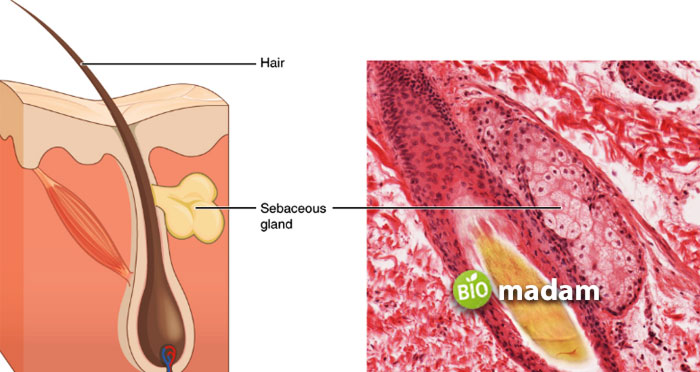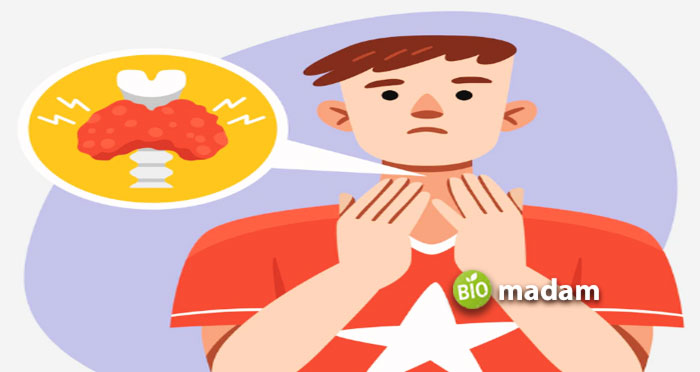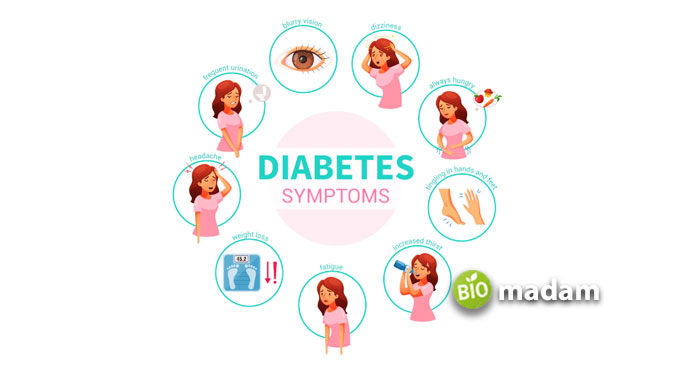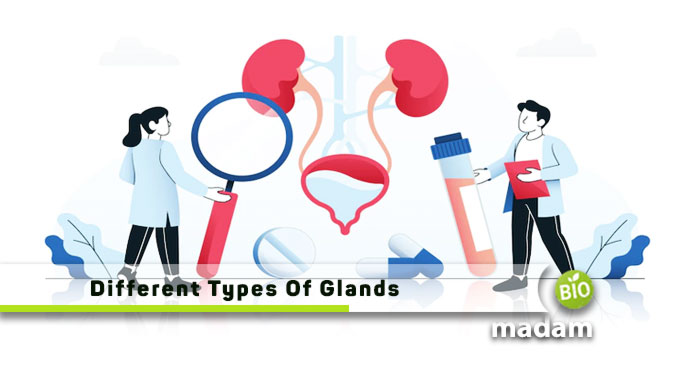Glands are an important part of the human anatomy, contributing to human physiology. They produce chemicals that facilitate different biological processes in the body for growth, development, metabolism, and reproduction. Normal levels of these chemicals in the body ensure healthy body functioning. Whereas fluctuations in these chemicals can lead to different diseases and disorders. We have compiled different types of glands and their functions for your easy understanding.
What are Glands?
Merriam-Webster defines a gland as “a specialized cell, group of cells, or organ of endothelial origin that selectively removes materials from the blood, concentrates or alters them, and secretes them for further use in the body or elimination from the body.”
Glands are secretory organs that secrete a chemical substance. The secreted chemicals may be hormones, saliva, sweat, mucus, or digestive juices. The function of glands in the body is either secretory or excretory. For example, pituitary glands secrete reproductive system regulation hormones and neurotransmitters, while sweat glands excrete the debris through the epidermis.
How are Glands Formed?
Glands can be considered as an ingrowth of the epithelium tissues. They are a group of tissues formed by embryonic germ layers involved in secretion, absorption, and selective diffusion. Compared to epithelial tissues, connective tissues do not show involvement in developing glands.
Types of Glands
Glands are categorized into two groups based on their function:
- Exocrine glands
- Endocrine glands
Exocrine glands transport the chemicals to the target cell or epithelial surface through a duct. On the other hand, endocrine glands excrete chemicals that reach the target location through the bloodstream. Different glands perform unique bodily functions and facilitate survival and growth. Here’s everything you need to know about exocrine and endocrine glands.
Exocrine Glands
Exocrine glands secrete chemicals onto epithelial cells or tissues through a duct. An exocrine gland comprises two parts: a duct and a secretory unit. The secretory unit comprises epithelial cells involved in secretions. The duct transports the secretions from the secretory unit to the target surface.
Exocrine glands are mostly involved in the secretion of tears, saliva, sweat, digestive juices, and milk.
Functions of Exocrine Glands
The function of each exocrine gland depends on the body organ it is associated with. Exocrine glands excrete different types of chemicals to perform their specific function. The functions of different exocrine glands in your body include:
- Digestion and absorption of nutrients
- Maintaining the body temperature
- Lubrication of eyes, hair, and skin
Exocrine Glands in the Body
Sweat Glands
The sweat on your face and body on a hot day is attributed to the functioning of the sweat glands. They produce and secrete sweat to maintain the temperature of your body. Sweat glands are of two types: apocrine and eccrine.
Apocrine glands are found in hairy body areas, like the armpit and genital area. They typically secrete a milky fluid instead of the clear sweat from eccrine glands. The release of fluid takes place in stress conditions. Other body areas with apocrine glands include the nose, ears, eyelids, and areola. Alternatively, eccrine glands on the skin release water-like, non-oily sweat to help control body temperature.
Salivary Glands
Salivary glands are responsible for producing saliva that helps the breakdown of food. The salivary glands are present in the buccal cavity. Hundreds of small glands in the mouth cover your tongue, palate, cheeks, and lips. They produce saliva and release it into your mouth through ducts. Saliva also lubricates and protects the inner lining of your oral tissues. Different types of antibodies in saliva help kill germs and keep your mouth healthy.
There are three major pairs of salivary glands in your buccal cavity
- Sublingual glands present under your tongue
- Submandibular glands located below your jaw
- Parotid glands below and in front of the ears
Sebaceous Glands
The sebaceous glands are present throughout your skin. They open into your hair follicles and secrete an oily substance, ‘sebum,’ to lubricate your skin. A few sebaceous glands also open directly onto the skin’s surface, including the Tyson glands on the foreskin and Meibomian glands on the eyelids. However, your soles and palms do not have sebaceous glands.
The sebaceous gland secretions help your body in the:
- Keeping your skin moisturized
- Regulating the body temperature with sweat glands
- Help fight infections caused by fungi, viruses, and bacteria

Lacrimal Glands
Lacrimal glands are tear glands present above your upper eyelids. They produce and secrete a fluid that keeps your eyes moist. This fluid is released by the glands every time you blink. Tears also help focus light so you can see clearly. They protect your eyes from dust and other particles, saving them from bacterial and viral infections.
Mammary Glands
Mammary glands are present in the females of mammals and produce milk for the offspring. They arise from glandular tissue, which is a type of epithelial tissue. While these tissues are also present in males, estrogen production during puberty boosts the growth of glandular tissues in females.
Mammary glands produce milk due to hormonal changes in the body that signal milk production. Breast Milk is nutrient-rich and important for the infant’s growth. It also contains antibodies to develop immunity against diseases and infections.
Stomach Glands
Glands in your stomach produce digestive enzymes and hydrochloric acid, also known as stomach acid. Your stomach has three glands: cardiac, gastric, and pyloric. They facilitate the breakdown and absorption of food into the bloodstream.
Brunner Glands
Your intestine contains Brunner glands in the duodenum (the first part of the intestine). These glands secrete mucus to protect your small intestine as it has to perform various functions in the digestive system. Brunner Glands also secrete ‘secretin’, which is a stimulatory hormone. It triggers the activity of the liver and pancreas.
Ceruminous Glands
The ceruminous glands are present in your ears and help produce ear wax. Ear wax protects you against infections and physical damage to the inner ear. However, the wax may not hinder water from entering the ear during swimming.
Endocrine Glands
Endocrine glands in the body make up the endocrine system. The glands of the endocrine system produce hormones that enable communication between cells. Hormones contribute to all body functions in one way or another. They are responsible for coordination, metabolism, growth, development, mood, emotions, sleep, and sexual functions.
Functions of Endocrine Glands
The endocrine system secretes hormones and keeps the number of hormones in control. The pituitary gland monitors the hormones in the bloodstream and signals the glands to produce more or fewer hormones accordingly. This process of regulating hormones is known as homeostasis. The primary functions of the endocrine system in your body include
- Growth and development
- Emotions
- Mood
- Metabolism
- Sleep
- Sexual function
Endocrine Glands in the Body
Hypothalamus
The hypothalamus is located in your brain and is a part of your autonomic nervous system. It is the control room of your endocrine system. It stimulates the production of hormones and regulates optimum levels. The hypothalamus initiates signals considering the number of hormones in the blood and instructs the production or inhibition of hormones. Eventually, it is responsible for controlling various processes in the body, like hunger, thirst, sleep, mood, memory, and sexual function.
Pituitary Gland
The pituitary gland is a pea-sized gland present at the base of the brain. It is divided into two parts for simplified understanding:
- Anterior pituitary or adenohypophysis
- Posterior pituitary or neurohypophysis
The pituitary is also known as the master gland as it uses the information from the hypothalamus to facilitate the production of hormones. The pituitary gland secretes growth hormone, antidiuretic hormone (ADH), aldosterone, thyroid stimulating hormone (TSH), prolactin, oxytocin, etc.
The functions of hormones produced by the pituitary gland are as follows:
- Thyroid Stimulating Hormone (TSH) stimulates the production of thyroid hormones (T3 and T4) that significantly regulate metabolism. Besides being from the endocrine system, they maintain nervous system activities and contribute to energy homeostasis. A sudden increase or decrease in thyroid hormone levels may lead to hyperthyroidism and hypothyroidism, respectively.
- Growth hormone improves growth in children and maintains body tissues and organs in adults. A higher amount of the hormone in children leads to gigantism, in which their size increases abnormally. At the same time, the overproduction of growth hormones in adults causes acromegaly.
- Adrenocorticotropic hormone (ACTH) signals the adrenal gland to secrete hormones such as cortisol under stressful conditions. The high release of cortisol regulates bodily functions during stress by increasing glucose metabolism, reducing inflammation, and maintaining blood pressure. It also helps the body regulate the fight or flight response by the sympathetic nervous system. Low ACTH levels cause adrenal insufficiency, whereas a higher level results in Cushing’s syndrome.
- Follicle-stimulating hormone (FSH) and luteinizing hormones (LH) are together called gonadotropins. They stimulate the production of estrogen and progesterone by the ovaries and testosterone by the testes. They play a critical role in the growth and maturation of eggs and sperm. Fluctuation in the production of FSH and LH may lead to sexual function disruption and infertility.
- Oxytocin is an important hormone during pregnancy and lactation. It stimulates uterine contraction during labor for the delivery of the baby and contributes to milk production in lactating mothers.
- Prolactin also contributes to the stimulation of mammary glands to produce milk. However, a high prolactin level may impact the function of reproductive organs, including ovaries and testes.
- Antidiuretic hormone (ADH) is involved in maintaining the blood pressure in your body. It is also known as vasopressin. ADH or vasopressin regulates mineral concentration, water retention, and fluid balance. It constricts the arteries and veins per need.
Thyroid Gland
The thyroid gland is one of the most important glands in your body as it controls metabolism and growth. It is present in the front of your neck below the larynx. The thyroid gland is in the shape of a butterfly and around 2 inches in size. Thyroid hormones (T3 and T4) secreted by the thyroid gland affect all tissues and functions in your body. Eventually, these two hormones are essential for the body’s normal anatomical and physiological features. Accelerated or suppressed thyroid function impacts body metabolism and other processes leading to changes in body form. Check out the thyroid hormone tests and their normal range here.

Parathyroid Gland
There are four tiny parathyroid glands located behind your thyroid. They are as small as the size of a grain of rice and have a major role in controlling phosphorus and calcium levels in your body. The right amount of calcium saves you from bone issues like osteoporosis and contributes to the heart, nervous systems, and kidney functions.
Adrenal Gland
Your body has two adrenal glands, one on the top of each kidney. They produce various hormones, some of which are involved in the ‘fight or flight’ response. Besides the immune response, it also regulates blood sugar and blood pressure, burns saturated and unsaturated fats, and reacts to stress. The hormones produced by adrenal glands include aldosterone, cortisol, adrenaline, and androgens in small amounts.
Thymus
The thymus gland plays a vital role in various types of body immunity by producing T-lymphocytes that kill cancer cells and help B-kill remove invading antigens and pathogens. However, the thymus shrinks after puberty.
Pineal Gland
The pineal gland is in the center of your brain and helps the sleep cycle through the hormone melatonin. Melatonin regulates the sleep pattern through circadian rhythms. The pineal gland also contributes to managing the appropriate release of female hormones involved in the menstrual cycle.
Ovaries
Ovaries are reproductive organs that produce sex hormones in women. Every woman has two ovaries located on each side of the abdomen. They release progesterone, estrogen, and testosterone. These hormones regulate the menstrual cycle, develop secondary sex characteristics, and support pregnancy.
Testes
Testes are the sex hormone-regulating glands in men. They produce testosterone that grows the body and facial hair at puberty, besides other secondary sex characteristics. It improves muscle strength, sperm production, and sex drive.
Dual-Role Glands
Glands are primarily divided into two types only: exocrine and endocrine. Yet, two glands in your body (liver and pancreas) can be put into both categories. Thus they are also called dual-role glands.
Pancreas
The pancreas may be considered exocrine and endocrine at the same time. They secrete hormones into your bloodstream, but the pancreatic juices reach the target site through ducts in the GI tract. The endocrine and exocrine function of the pancreas depends on the type of secretion. The two important hormones produced by the pancreas include insulin and glucagon. An increase or decrease in insulin production may lead to diabetes or hypoglycemia. The pancreas also secretes somatostatin, serotonin, vasoactive intestinal peptide (VIP), and pancreatic polypeptide (PP).
Liver
The liver is also a dual-role gland like the pancreas. It secretes bile into the gastrointestinal tract through ducts. On the other hand, the four major hormones in the liver (insulin-like growth factor, angiotensinogen, thrombopoietin, and hepcidin) travel through the bloodstream.
Exocrine and Endocrine Glands Disorders
Thyroid Disorders
Thyroid hormones are vital to metabolic functions, and fluctuations can lead to various health issues. Hypothyroidism and hyperthyroidism are quite prevalent in women due to underactive or overactive thyroid. Hypothyroidism results from low thyroid levels, whereas hyperthyroidism indicates a high thyroid hormone level. Any of these conditions may lead to an enlarged thyroid.
Your metabolism slows down in hypothyroidism and accelerates in hyperthyroidism. Thus, people with hyperthyroidism lose weight and experience muscle weakness. On the other hand, hypothyroidism leads to weight gain and fatigue.
Diabetes
Diabetes is another common hormone-related health issue affecting 537 million adults globally.
Diabetes results from a lower secretion of insulin from the pancreas leading to higher blood sugar. Sometimes, the pancreas may produce insulin but does not bind to the glucose molecules.
Diabetes can be managed with medication but sometimes leads to other diseases. It is important to manage diabetes to prevent other related issues.

Salivary Gland Disorders
Sometimes autoimmune diseases, infections, cysts, or tumors in the mouth may restrict the activity of salivary glands. When the salivary glands do not produce enough saliva, it can affect swallowing and chewing and increase the risk of oral infections. Treatment of salivary gland disorders depends on the underlying cause.
Cushing’s Syndrome
Cushing’s syndrome results from the overproduction of cortisol. Cushing’s syndrome is characterized by weight gain, a fatty hump between your shoulders, pink or purple stretch marks on your skin, and weak muscles and bones. It may also lead to high blood pressure and type 2 diabetes.
Acromegaly
Acromegaly is an excess of growth hormone produced by the pituitary gland. It results in bigger feet, hands, and enlarged faces. The size of body parts increases because of abnormal bone growth. Acromegaly symptoms typically exhibit in middle age.
Multiple Endocrine Neoplasia
Multiple endocrine neoplasia refers to benign or malignant tumors in two or more endocrine glands in the body. It can be fatal if not diagnosed and treated in time, preventing the normal function of different endocrine glands.
Hypogonadism
Low testosterone production in men results in hypogonadism which may cause erectile dysfunction. Symptoms of hypogonadism include a low sex drive, memory and concentration issues, fatigue, and reduced muscle strength.
PCOS
PCOS is a common reproductive hormone disorder due to cysts in the ovaries. It restricts the ovaries’ function of developing or releasing eggs properly. This imbalance of hormones can disturb your period, cause acne and lead to hirsutism.

The Bottom Line
Endocrine and exocrine glands release essential chemicals, including hormones necessary for normal body function. Endocrine glands release the hormones directly into the bloodstream, whereas exocrine glands secrete chemicals through ducts. Fluctuations in any of these hormones can lead to various disorders within the body. Proper intake of micro and macronutrients may help maintain optimal hormone levels. The conditions must be treated in time if not managed by nutrition intake.

Anna has completed her degree in Pharmacy from the University of Hawaii. She is serving as a research assistant in a pharmaceutical company. She had a great interest in writing blogs, traveling to different parts of the US, and trying delicious recipes in her spare time.

